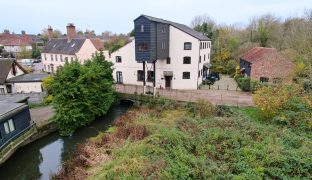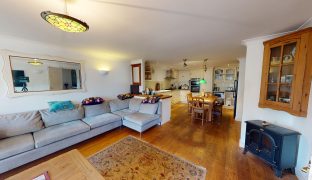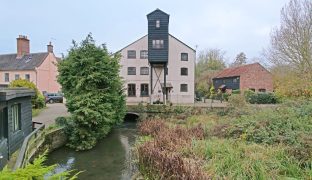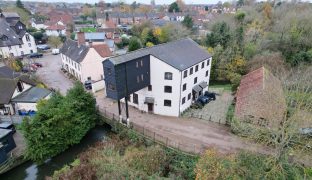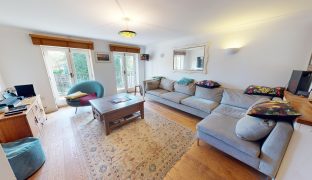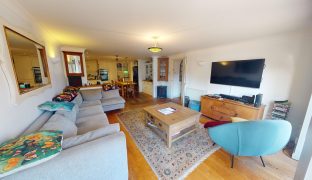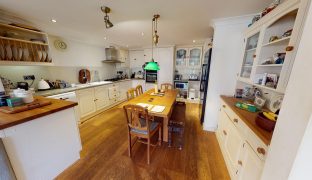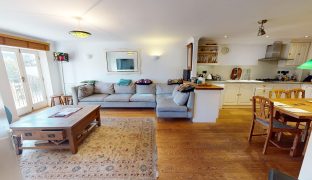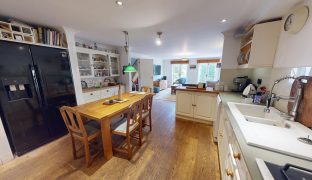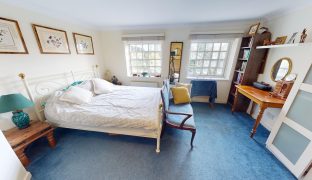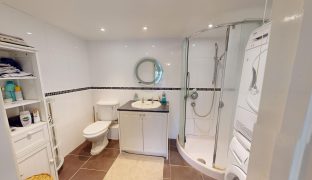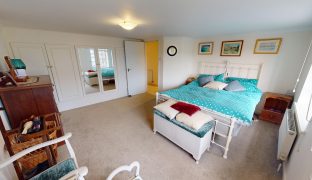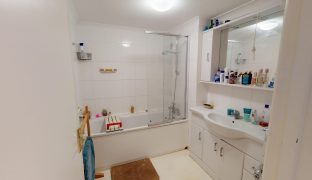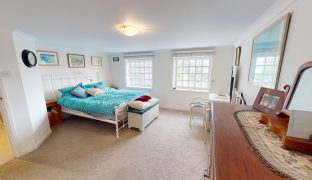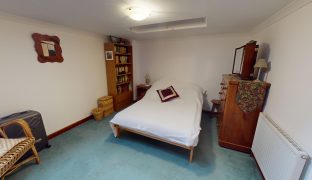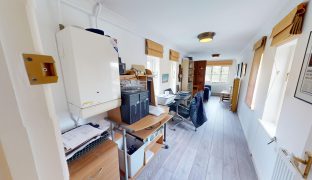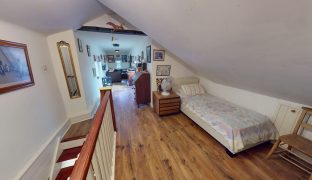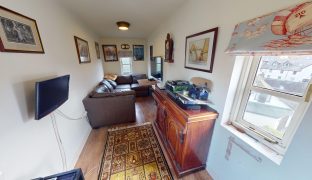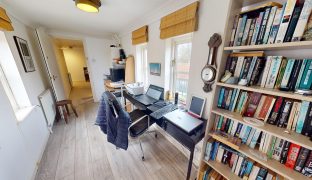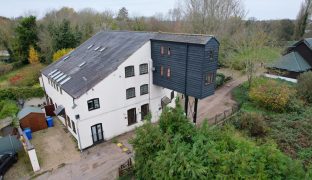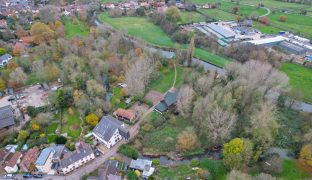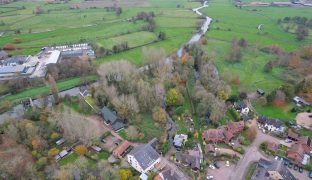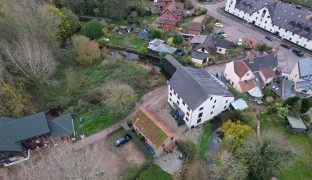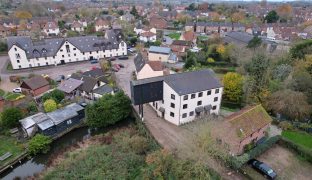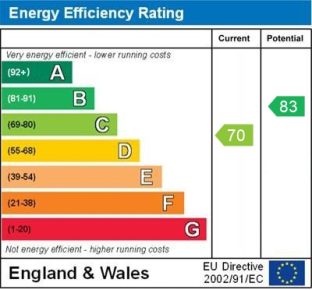An impressive four storey conversion full of character and charm, part of a historic water mill just off the River Waveney. With versatile accommodation a 28ft long open plan living/dining/kitchen area, within walking distance of the town centre and the nearby meadow.
Key Features
- An impressive four storey conversion of part of an imposing water mill
- Full of character and charm
- Spacious and versatile accommodation
- Walking distance of the centre of town
- Scenic riverside walks close by
- 4 double bedrooms including a generous master bedroom with en-suite facilities
- Private garden
- Off road parking
About this Property
An impressive four storey conversion of part of an impressive water mill set looking out over the water just off the River Waveney.
Full of history, character and charm, this substantial and flexible waterside residence is set within easy walking distance of the centre of Bungay, a beautiful, well served market town on the Norfolk/Suffolk border.
The versatile accommodation consists of an entrance hall, a 28ft long open plan living room/dining room/kitchen, the perfect space for entertaining. A generous master bedroom with en-suite shower room, three further double bedrooms, family bathroom and a study which is set in the imposing gantry section of the mill with impressive far reaching views out over the Waveney Valley.
This unique property is equally suitable as a substantial main residence or as a well placed second home with off road parking and a private enclosed garden, completely unseen from the property and the road.
As well as having a vibrant town centre close by, this property is also located a few steps away from Falcon Meadow, a beautiful riverside parcel of land extending to over four acres, the perfect haven for local wildlife as well as a dog walkers paradise and the ideal spot to fish or to launch kayaks and paddleboards.
A fascinating property in a picturesque and convenient location that needs to be seen to be fully appreciated.
ACCOMMODATION
Entrance Hall
Part glazed front door, steps up to a half landing leading to:
Open Plan Living Room: 28’7″ x 13’9″
Spacious living area, the perfect space for entertaining. Two sets of French doors, both with Juliet balconies looking out over the bridge and the water beyond. Wooden floor, radiators, coved ceiling and a fully fitted kitchen/dining area with a comprehensive range of wall and floor mounted units, 1½ sink unit and drainer, built in double oven with five ring gas hob and extractor hood, plumbing for a dishwasher, large dresser unit and space for an American style fridge freezer. Down lighters and wall lights.
FIRST FLOOR
Master Bedroom: 15’8″ x 13’9″
Two windows to front aspect with picturesque views. Radiator, coved ceiling.
En-Suite Shower Room
Shower enclosure, vanity wash basin, w/c, fully tiled, heated towel rail, plumbing for washing machine, extractor, down lighters.
Landing
Staircase to second floor, radiator, coved ceiling, down lighters.
Bathroom
Panelled bath with shower attachment and screen, vanity wash basin, heated towel rail, partially tiled walls, coved ceiling.
Separate w/c
Low level w/c, hand basin, extractor fan, coved ceiling.
SECOND FLOOR
Landing
Radiator, coved ceiling, down lighters, staircase to third floor.
Bedroom 2: 13’9″ x 13’8″
Two windows to front aspect with views over the water. Range of built in wardrobes. Coved ceiling, radiator.
Bedroom 3: 12’7″ x 10’6″
Two sky lights, radiator, coved ceiling.
Study: 22’8″ x 5’9″
Set within the gantry section of the old mill. Triple aspect with far reaching views. Radiator, coved ceiling.
THIRD FLOOR
Bedroom 4: 32’9″ x 12’3″
L-shaped room taking up the second floor of the gantry, triple aspect with far reaching views. Access to a large walk in loft area.
OUTSIDE
Set back from the property, away from the road and accessed by a pathway is a private garden, well enclosed with a large summer house.
There is also private car parking for residents of the mill.
HISTORY
At one time, over a dozen working water mills harnessed the power of the River Waveney as it descended from Diss to meet the tidal waters of the Broads system just above Beccles. The disappearance of many of these mills is mainly due to the inherent dangers of grain milling, an explosive process fraught with the constant risk of fire. This risk was exacerbated by the fact that early mills were almost exclusively constructed from wood.
Bungay Mill, also known at various times as Bardolph’s Mill, is believed to have been rebuilt after at least six fires before enduring into the late 19th century, when it was finally equipped with a robust Victorian brick superstructure. Its sturdy construction has ensured its survival and contributed to its striking and iconic appearance today.
The mill’s prominence owes much to its role in handling cargo from trading vessels during Bungay’s time as a thriving inland port. Situated at the furthest navigable point on the River Waveney, Bungay flourished following the implementation of the 1670 Navigation Act which saw the construction of four modest shipping locks between Bungay and Beccles, enabling the transport of goods such as grain and coal.
The mill’s giant lucum, an overhanging structure designed to lift heavy grain sacks from vessels like the wherry Albion, is considered the best and largest surviving example of its kind in inland Britain. Today, these twin loading gantries are integral features of Millstream House, repurposed as a study and a TV and viewing lounge.
During its heyday, Bungay’s navigation handled hundreds of tonnes of goods, generating immense wealth for the mill operators. So successful was this trade that in 1870 plans emerged to extend the navigation to Diss. However, the rise of steam railways and, later, motorised road transport rendered such plans obsolete.
By 1934, the middle stretch of the River Waveney had silted up due to the decline of commercial river traffic, effectively ending Bungay’s status as a port. Despite these challenges, Bungay Mill adapted, continuing operations through two world wars by milling grain and processing paper. Eventually, the millstones were removed, the waterwheel dismantled for scrap, and the building repurposed for the production of small fibreglass boats.
When this enterprise ceased in the mid-1990s, the mill was converted into residential accommodation. Due to its original load-bearing floors, conventional conversion was impractical, resulting in the creation of four vertically structured maisonettes. Millstream House, the largest of these, spans four floors and retains the historic lucum, offering views over the Millstream and the surrounding water meadows and willow plantations.
The property’s unique history and idyllic setting make it an exceptional family home, blending modern living with the echoes of a bygone era.
Its historic status, together with its location and the potential to sleep and dine up to 10 persons, renders the property an excellent prospect in the buy to let staycation market.
Less than 30 minutes from the Suffolk Heritage coast and its jewels like Southwold and Aldeburgh, it is also a gateway onto the Bungay Loop, a massive meander of the beautiful non-tidal River Waveney, which has long been a mecca for Canoeists (and now Paddleboarders) who flock to it from all parts of Britain.
Its spacious waterside remote garden with barbecue area also boasts a large summerhouse/small craft storage area with private access to the Loop’s downriver portage facility. Whilst back at the house, secure parking is available for up to 5 vehicles.
ADDITIONAL INFORMATION
Freehold.
Mains water, electricity and drainage.
Council Tax Band D
This property owns the bridge below the gantry with public access permitted by foot with restricted vehicular access.
Whilst it is our intention that these sales particulars offer a fair and accurate account, they are provided for guidance purposes only and do not constitute part of any offer or contract.
All measurements are approximate and we have not tested any equipment or services, and no warranty is given or implied that these are in working order.
Prospective purchasers are advised to satisfy themselves by inspection or by further investigation via their solicitor or surveyor.

